Best Wireless Thermometers: Pros, Cons, and What To Look For
Published On: 6/12/2025 Last Modified: 7/9/2025
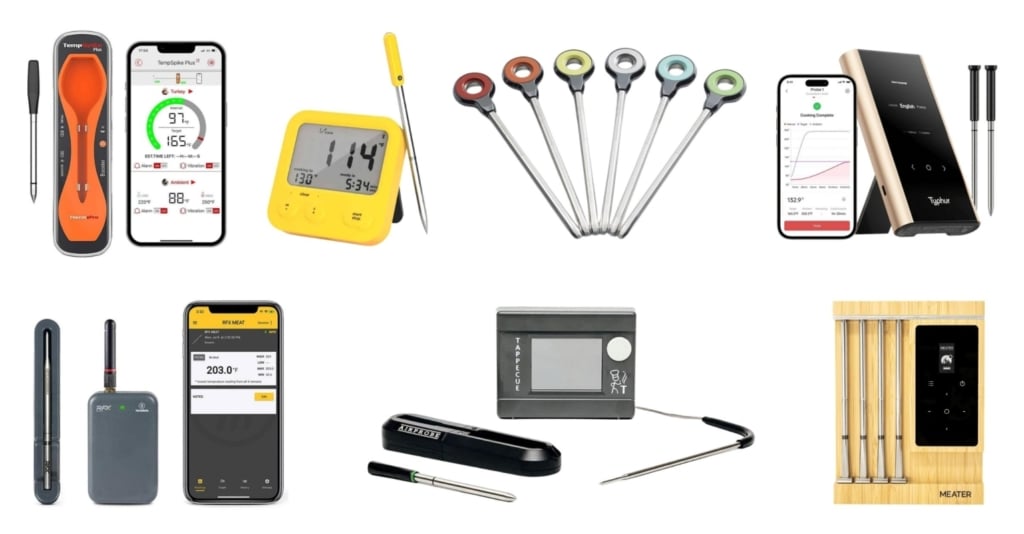
A guide to buying the best wireless thermometer for your needs
In 2015, Apption Labs introduced the first fully wireless food thermometer. It eliminated the need for external wires, which traditionally posed challenges like tangling, cutting, and failure due to heat. Although initially viewed with skepticism due to questions around signal strength, battery life, heat tolerance, and reliability, this innovation sparked a revolution in food thermometer technology. Wireless thermometers are now the hottest gear in outdoor cooking.
I put together this overview to help you choose the best wireless thermometer for your needs. It compares seven of the top products that we have reviewed and rated over the past few years and outlines the key features and criteria to keep in mind. Here are the seven products:
- Combustion Predictive Thermometer
- FireBoard Pulse
- Meater Pro Duo / Pro XL
- Tappecue AirProbe3 (Tappecue has since gone out of business)
- ThermoPro Twin TempSpike Plus
- ThermoWorks RFX Probe and Gateway
- Typhur Sync Gold Dual
Up your game: Join our Pitmaster Club. Try it out for free for 30 days. No credit card is needed. No spam. Join now and Be Amazing!
Product Review Summaries
As I was collecting the data for this comparison, several manufacturers brought out new products or made improvements. So I had to re-run some tests since my initial product reviews. I tried to eliminate products that had been superseded by newer models, but I wouldn’t be surprised if something new comes along immediately after this article is published. I will try to keep up with these ever-evolving products by adding new material to this comparison as it becomes available.
Nonetheless, below are very short summaries of each product we tested. For a visual comparison, see the “Pros and Cons” chart further down the article. And I highly recommend reading the “Evaluation Criteria & Key Features” section. That will give you a solid understanding of the variables to consider when choosing the best wireless thermometer for your needs. For more detailed reviews and to buy any of these products, just follow the links below to the original reviews.

Combustion Predictive Thermometer
Chris Young, founder of Combustion Inc. and creator of the Joule sous-vide immersion circulator, uses advanced sensor technology in his company’s wireless thermometer probe. The Combustion Predictive Thermometer system includes a probe, booster/charger, display, and smartphone app. The probe features eight sensors along its length to track temperature differentials and improve doneness predictions.
Combustion’s second-gen model is waterproof, safe to 900°F, and has 92-hour battery life. Data transmission is via Bluetooth and Wi-Fi, and the system supports cloud access through the display (no second phone is needed). Up to four probes can be monitored.
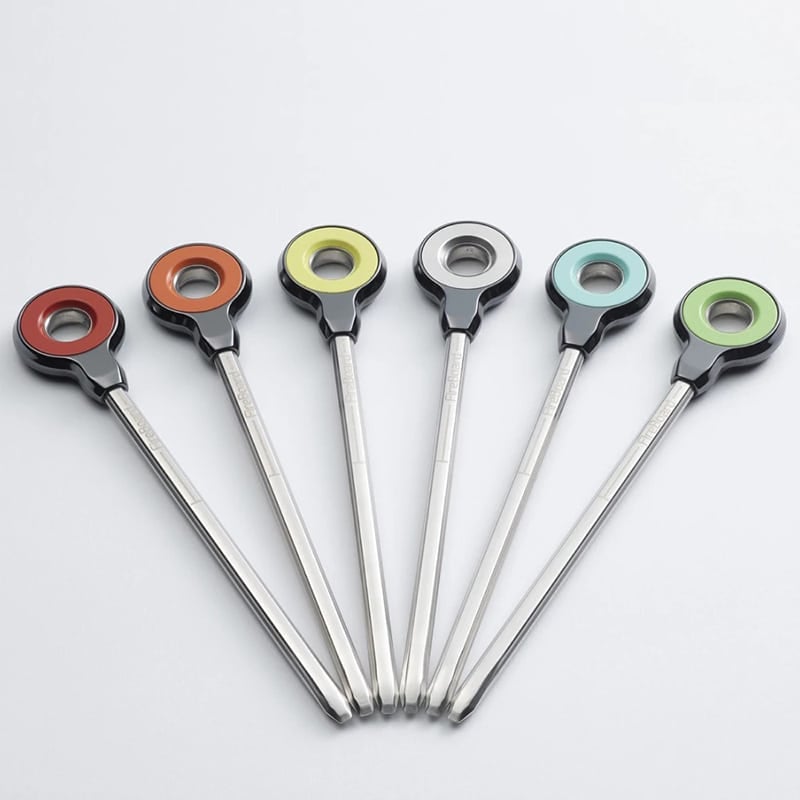
FireBoard Pulse
The Fireboard Pulse supports both Bluetooth and low-frequency RF (radio frequency) communication via FireBoard 2’s external antenna. This helps improve signal performance through the signal-attenuating medium of a metal cooker. Each probe has two sensors—one in the tip and one in the handle. Cleverly, the probes are recharged using cradles that stack magnetically and charge via USB-C. Up to eight Pulse charging cradles can be assembled at a time, and each has its own internal battery, keeping a Pulse charged for months.
Pulse integrates with the FireBoard Spark instant-read thermometer for instant reads and cloud uploads. The FireBoard app offers extensive monitoring and tracking features with a web portal available.
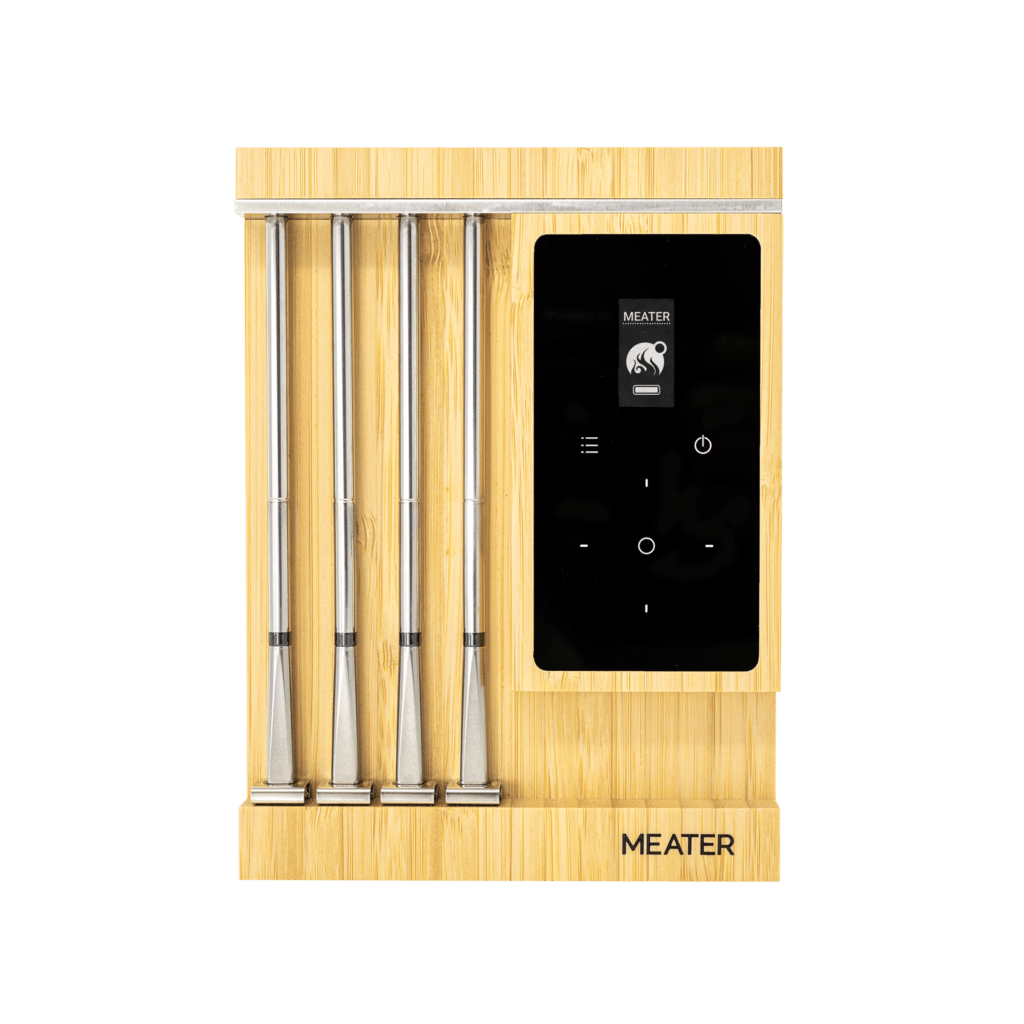
Meater Pro Duo / Pro XL
Meater’s Pro line includes probes with six sensors (five along the shaft, one in the handle). You must insert the probes at least as far as the minimum insertion mark etched on the probe body. You can purchase a single probe version, two-probe version, or four-probe version, known as the Meater Pro, Pro Duo, and Pro XL, respectively. The Pro Duo and Pro XL have Wi-Fi-enabled charging cradles for cloud access and offline use. The four-channel Pro XL has a display that allows you to monitor each probe without using your smart phone.
The app shows all six sensors, offers predictions, and allows at least six probes to connect. Firmware updates are managed via the app, though no web portal exists for desktop monitoring.

Tappecue AirProbe3
*NOTE: Tappecue has ceased operations, making long-term support uncertain. The following info is provided for comparison purposes only. Tappecue’s probes came in two sizes (AirProbe3 and Mini) and included a handle and tip sensor. Booster cradles doubled as chargers and amplifiers. They supported cloud monitoring through the Tappecue Touch device and app, with web portal access available for historical data.
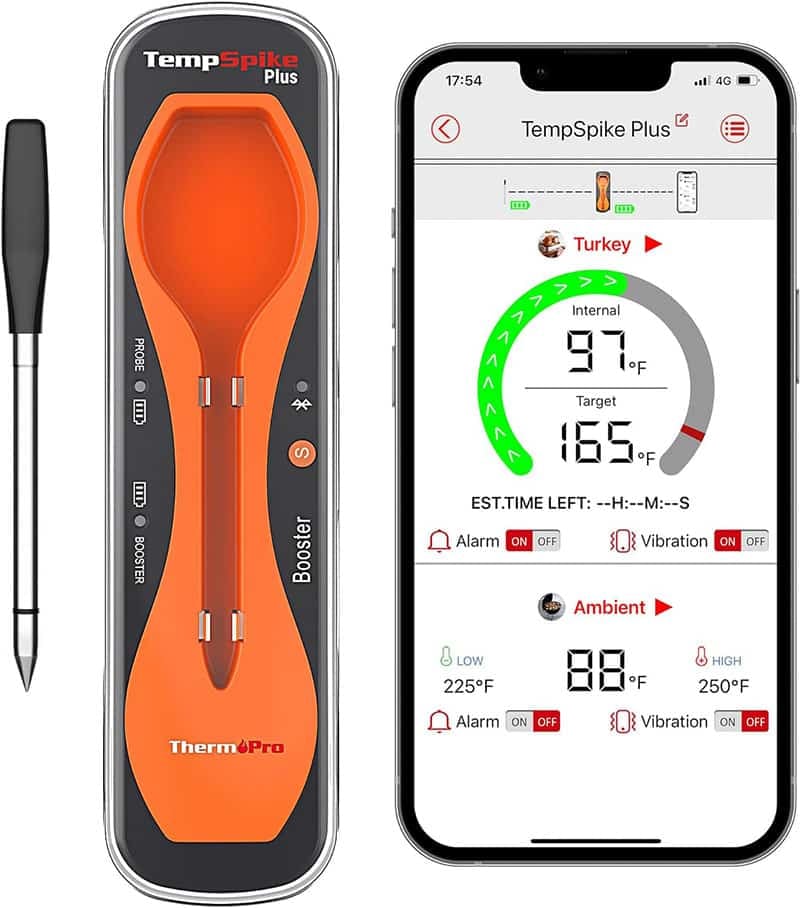
ThermoPro Twin TempSpike Plus
The ThermoPro Twin TempSpike Plus is the two-probe-with-booster version of the previously reviewed TempSpike Plus. This two-probe version displays tip and ambient temperatures. The probes are color-coded and recharge in a dual-slot cradle. The booster displays temps but lacks prediction capability itself.
There’s no cloud access or web portal, and Bluetooth is the only transmission method. Firmware update functionality is unclear.
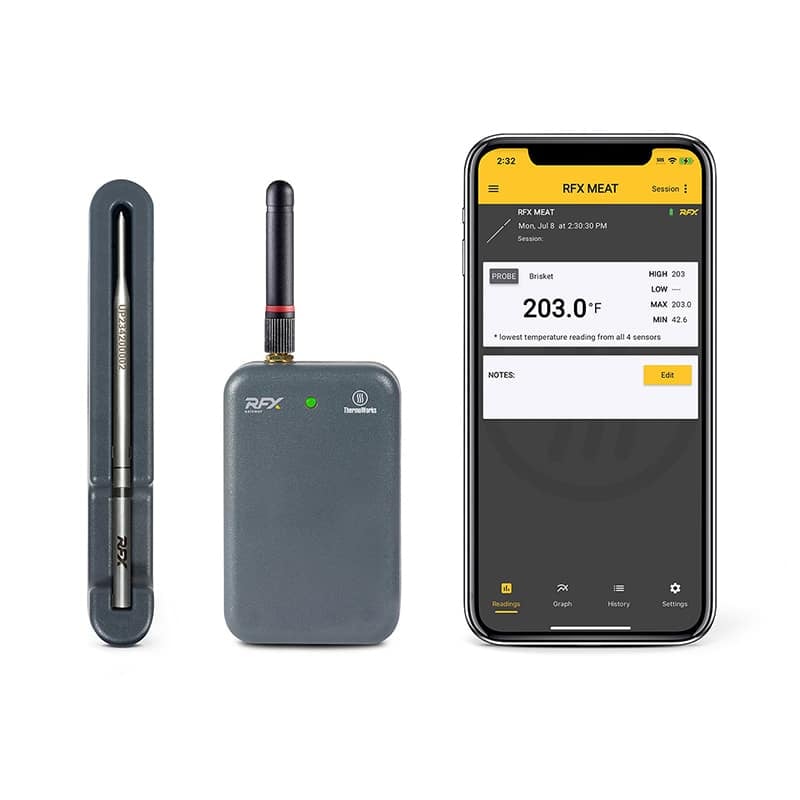
ThermoWorks RFX Probe and Gateway
In the ThermoWorks RFX Probe and Gateway system, the probe has four sensors near the tip and none in the handle. Instead, a separate wired probe measures ambient temp, which improves accuracy. The proximity of the probe to the gateway also reduces the energy required to send data, thereby extending the probe’s battery life and the interval between charges. The system uses low-frequency 433MHz radio frequency signals for extended range and reliability.
The app is evolving, and a desktop portal is available. Both the gateway and probe firmware can be updated.
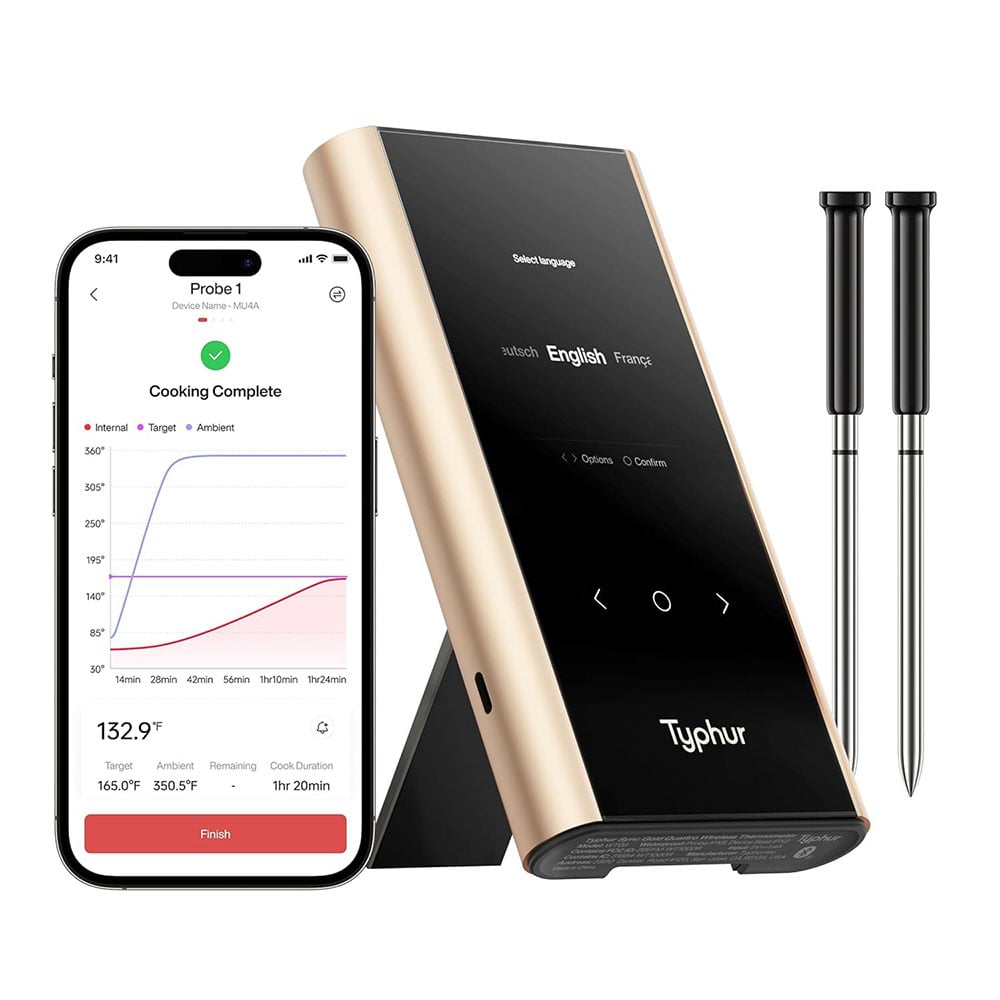
Typhur Sync Gold Dual
The Typhus Sync Gold Dual system uses low-frequency communication from probe to base and relays via Wi-Fi or Bluetooth. Each probe has six sensors (five in the shaft, one in the handle). The base charges probes, displays temps, and supports cooking without a phone.
The Typhur app stands out for ease of use and has both “smart” and “dumb” modes for cook predictions. It offers food-specific cook guidance and simple interface navigation.
Like what you’re reading? Click here to get Smoke Signals, our free monthly email that tells you about new articles, recipes, product reviews, science, myth-busting, and more. Be Amazing!
Evaluation Criteria & Key Features
All these products share some basic features, and each deviates from the wireless concept in ways that differentiate it from its competitors. Depending on your objectives, one product might stand out as the best wireless thermometer for your needs. Let’s look at the evaluation criteria and key features to consider.
Accuracy
I tested each probe using a dry well that maintains an accurate and steady temperature. I used a ThermoWorks Reference Thermapen that is accurate to less than a tenth of a degree Fahrenheit to fine-tune the dry well temperature. I tested the probes at 135°F (57°C), 160°F (71°C) and 205°F (96°C). These temps are the temperature of a medium-rare steak, the safe temp for a poultry breast, and the temp of a fully-cooked brisket or pork butt, respectively. Each probe was inserted tip first into the dry well and allowed to reach a stable temperature. All tested thermometers were accurate to within 1-2°F when measured against the calibrated reference. So accuracy isn’t a big differentiator among the wireless thermometers tested.
Ambient Temp Sensors
Most sensors in wireless probe handles aren’t reliable for ambient temperature readings due to proximity to the much cooler food. However, unless you need an accurate measurement of the cooker’s temperature from your meat probe, this error in the handle’s ambient reading won’t be a problem. A couple caveats here: if your wireless thermometer’s prediction algorithm uses the ambient temp to estimate the cook time, you might have a problem. Also, if you use the ambient temp reading to control a fan for temperature stabilization, you’ll definitely have a problem. ThermoWorks solves this problem with a separate wired probe, providing more precise ambient temp control for serious grillers.
The probe dimensions and arrangement of its temperature sensors are factors to consider. More sensors and flexibility with the insertion depth improve performance, especially when optimal placement of the probe is difficult. Below is a table showing various probe parameters, in inches. The depth range indicates how much latitude the cook has when inserting the probe in the food. The number of sensors shows the number of sensors in the probe body and in the probe handle. In the case of Combustion, the 4+4 indicates that it has four low-temp sensors at the tip end and four higher-temp sensors toward the handle end. In the ThermoWorks case, the asterisk indicates that the “handle” sensor is really a separate wired sensor.
| Product | Model | Probe Length (inches) | Minimum Insertion Depth (inches) | Depth Range (inches) | # of Sensors |
| Combustion | Predictive Thermometer | 3.8 | 2.0 | 1.8 | 4+4 |
| FireBoard | Pulse | 4.4 | 2.8 | 1.6 | 1+1 |
| Meater | Pro XL or Pro Duo | 5.0 | 2.5 | 2.5 | 5+1 |
| ThermoPro | Twin TempSpike Plus | 2.5 | 2.5 | 0.0 | 1+1 |
| ThermoWorks | RFX Meat and Gateway | 4.7 | 3.1 | 1.6 | 4+1* |
| Typhur | Sync Gold Dual | 3.4 | 2.9 | 0.5 | 5+1 |
Max Temperature Tolerance
Most probe tips are limited to around 212°F (100°C). Combustion and Meater allow tips to reach 220°F. As for the handles, max temperature tolerances vary widely:
- ThermoPro: 1050°F
- Meater: 1000°F
- Combustion: 900°F
- Typhur: 932°F
- Tappecue: 482°F
Battery Life
To test how long a probe will run on a single charge, I put the probe and its booster/charger about six inches apart, and ran a “cook” until the probe lost connection. If there were other pieces of hardware in the signal path, I ran them on AC power so they wouldn’t be the limiting factor. Here are the results, from longest run time to shortest (approximate hours):
- ThermoWorks: 92
- FireBoard: 43
- ThermoPro: 34
- Combustion (Gen 1): 30 (Gen 2 rated for 92)
- Meater: 28
- Tappecue: 26
Now for the tricky part: battery run times are affected by the signal path. To test the vulnerability of the communications to obstructions, I put the probes into a steel pistol case that is similar in construction to a smoker. I ran my duration tests on a couple of the products. I have more testing to do to quantify results, but the bottom line is that some, maybe all, will have shorter run times when they are inside a signal-absorbing enclosure like a smoker. I haven’t seen any discussion of this issue, but it’s real and will affect real world run times.
Communication & Range
Everyone wants to know how far they can expect to be from their cooker before they lose their connection. If you’re relying on Wi-Fi and the web, you can retrieve your data anywhere you have an internet connection. If you’re relying on Bluetooth, the question is very difficult to answer. In theory, the probe and your smart phone communicate directly via Bluetooth—no signal booster or Wi-Fi required. Unfortunately, Bluetooth, in an attempt to keep power consumption to a minimum, has only a short range. To make matters worse, it operates in the 2.4GHz range, so its signal is quickly degraded when inside a metal-walled cooker. Other obstructions, like walls, trees, and wet weather, further attenuate the signal, resulting in dropped connections.
All of the systems we tested use Bluetooth. Some add Wi-Fi or low-frequency signals to improve the communication range. Here’s a summary of the communication systems used by each product tested:
- FireBoard: 900MHz + Wi-Fi + Bluetooth
- ThermoWorks: 433MHz + Wi-Fi
- Combustion, Meater, Tappecue: Bluetooth + Wi-Fi (via booster)
- ThermoPro: Bluetooth only
Web portals are available for FireBoard, Tappecue, and ThermoWorks. Most support cloud uploads through their app.
Software & Apps
After you’ve set up your new, fancy thermometers, configured their repeaters, and paired your hardware, you still have to work with the apps that the manufacturers have created. Anyone under 16 seems to have been born with the DNA that permits them to pick up a smart phone and magically understand how to make it sing. I’m an old fart; I struggle with the inconsistent user interfaces that populate the world of cooking thermometers. To make matters worse, most manufacturers expect that users can figure out how to find just what they need without any assistance from a user’s manual. I, for one, cannot!
I can’t help but think that some of the app developers are more impressed with programming gimmickry and have never boiled an egg. Cooking is a task that progresses linearly; there’s a logical progression of events from the start to the finish.
A few suggestions for app developers: Write an app from the cook’s point of view. Walk me through starting a cooking session, presenting the steps in the decision-making process in a logical order. Make the “Back” button work the same way on all screens; don’t use it to close the app. If I’m going to terminate a session, give me an option that doesn’t require saving it. Please put both the time of day and the cook duration on the x-axis of the temp graph. Display how long the cook has been in progress as well. Scale the graph so it’s readable. Don’t make a section of the screen a navigation button without making it look like a button. I shouldn’t have to be poking at words or numbers to see if they’ll take me somewhere useful. Tell me the status of the batteries in a way that makes sense, like “4:35:00 remaining,” not a tiny icon that looks like a battery. Put a link in the app that points to a downloadable manual that has a change log at the front so users can see what’s new.
You get the picture: apps vary greatly in quality. I’m not happy with most of the ones that control wireless thermometers. I will say that Meater and Typhur score best for user-friendliness.
Prediction Algorithms
Many of these thermometers have a prediction feature that purports to tell the cook when the food will be ready. But prediction is limited by the variable nature of food and cooking. Bigger cuts like brisket and pork butt will probably experience a temperature stall of indeterminate length. Variations in meat thickness and composition, reverse-sear vs. sear-and-move techniques, and carry-over cooking also complicate any doneness time estimates. In the best-case scenario, I’d like to be able to choose how the time estimate is a calculated. I’d like to choose between “smart mode” and “dumb mode”. In smart mode, I select if I want carry-over, searing, or other factors to be included in the time prediction. In dumb mode, those mental gymnastics are left to me, and the prediction feature just tells me when my target temperature will be reached as soon as possible. Typhur’s app excels here, while others are inconsistent or opaque.
Want a new set of tools? Check out Meathead’s new book, The Meathead Method. It’s a toolbox that will elevate all your cooking. Alton Brown calls it “The only book on outdoor cookery you’ll ever need.”
Wireless Thermometer Comparison: Pros & Cons
As you can see, there’s a lot to consider when choosing the best wireless thermometer for your needs. It all comes down to what you want most out of the product. Use the chart below to compare each product’s strengths and weaknesses. Each of the products below received a Gold Medal, with the exception of the Combustion Predictive Thermometer, which received a Platinum medal. (Click here to read more about our product reviews, ratings, and medals.) Stay tuned for product improvements and new product releases. This article is a work in progress and I will update it as necessary.
| Product | Pros | Cons |
| Combustion Predictive Thermometer | – 8-sensor design for high accuracy – Moisture-proof and 900°F handle rating – Long 90+ hour battery life (claimed for 2nd gen model) – Wi-Fi booster and app updates – Up to 4 probes | – No web portal – Requires multiple hardware pieces – App learning curve |
| FireBoard Pulse | – Dual-frequency (900MHz + Bluetooth) for strong range – Magnetic stacking chargers – Works with FireBoard 2 and Spark – Web portal and cloud data | – Only 2 sensors (tip + handle) – Requires external hardware for best performance |
| Meater Pro Duo / Pro XL | – 6-sensor probe for detailed cooking data – Wi-Fi cradle enables remote access – XL has built-in display – Easy-to-use app | – No desktop portal – Long probe may be hard to use in small cuts of meat – Ambient sensor in handle |
| Tappecue AirProbe3 (Discontinued) | – Supported cloud access & web portal (formerly) – Two size options – Booster cradle extended range | – Company no longer active – Only 2 sensors – Long-term support uncertain |
| ThermoPro Twin TempSpike Plus | – Budget-friendly – High handle heat tolerance (1050°F) – Simple on-device readout – Color-coded probes | – No Wi-Fi or cloud access – No web portal – Must insert fully (0″ depth range) |
| ThermoWorks RFX Probe & Gateway | – Separate wired ambient sensor for accuracy – Uses robust 433MHz signal – Long battery life (92 hrs) – Web portal available | – Long probe length – App still under development – Needs gateway device |
| Typhur Sync Gold Dual | – 6-sensor probes – Smart & dumb prediction modes – Wi-Fi and Bluetooth via base – Best app interface – No phone needed to monitor | – Must insert deeply to protect handle – Battery life shorter than top-tier competitors |
Related articles
- How to Buy the Best In-Food And In-Cooker Thermometer
- How To Buy The Best Instant Read Thermometers
- How to Buy the Best Infrared Thermometer
Related reviews
- Combustion Predictive Thermometer Review And Rating
- FireBoard Pulse Wireless Temperature Probe Review And Rating
- Meater Pro Duo Wireless Food Thermometer Review And Rating
- Meater Pro XL Wireless Meat Thermometer Review And Rating
- Tappecue Airprobe 3 Review And Rating
- ThermoPro Twin TempSpike Plus Review And Rating
- ThermoWorks RFX Wireless Thermometer Review And Rating
- Typhur Sync Gold Dual Review and Rating


High quality websites are expensive to run. If you help us, we’ll pay you back bigtime with an ad-free experience and a lot of freebies!
Millions come to AmazingRibs.com every month for high quality tested recipes, tips on technique, science, mythbusting, product reviews, and inspiration. But it is expensive to run a website with more than 2,000 pages and we don’t have a big corporate partner to subsidize us.
Our most important source of sustenance is people who join our Pitmaster Club. But please don’t think of it as a donation. Members get MANY great benefits. We block all third-party ads, we give members free ebooks, magazines, interviews, webinars, more recipes, a monthly sweepstakes with prizes worth up to $2,000, discounts on products, and best of all a community of like-minded cooks free of flame wars. Click below to see all the benefits, take a free 30 day trial, and help keep this site alive.
Post comments and questions below
1) Please try the search box at the top of every page before you ask for help.
2) Try to post your question to the appropriate page.
3) Tell us everything we need to know to help such as the type of cooker and thermometer. Dial thermometers are often off by as much as 50°F so if you are not using a good digital thermometer we probably can’t help you with time and temp questions. Please read this article about thermometers.
4) If you are a member of the Pitmaster Club, your comments login is probably different.
5) Posts with links in them may not appear immediately.
Moderators